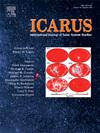Analysis of pit craters on asteroids and small bodies: Predictions about the regolith layer and internal structure
IF 2.5
2区 物理与天体物理
Q2 ASTRONOMY & ASTROPHYSICS
引用次数: 0
Abstract
In this work, we investigate and compare potential features called pit craters on the surfaces of (951) Gaspra, (243) Ida, (433) Eros, and the Martian moon, Phobos. Pit craters are typically arranges as chains on the surface and appear to be formed by the drainage of overlying loose material into internal voids promoted by fractures, assessing a piece of direct information about the approximate thickness of the regolith layer, and the internal configuration of each small body. Methodologically, we analyzed images taken by Galileo, NEAR Shoemaker, and other Martian rendezvous missions and mapped these geological morphologies across their surfaces. We analyzed pit sizes using Analysis of Variance and looked for correlations in terms of their different intrinsic physical properties. The pit sizes range between 0.034 and 0.971 km and their estimated regolith layers between 100 and 300 m thick for the four bodies. We demonstrated a strong correlation between the mean diameter of these depressions and the density of the body, making possible a linear model to predict the size of pit craters on small bodies to be visited in future missions, such as Deimos or asteroid (16) Psyche. We also proposed an internal fracturing index for these small bodies that shows a strong correlation with each mean body density. The data provided by future missions for different pitted small objects will allow us to validate or reject these models and predictions.
求助全文
约1分钟内获得全文
求助全文
来源期刊

Icarus
地学天文-天文与天体物理
CiteScore
6.30
自引率
18.80%
发文量
356
审稿时长
2-4 weeks
期刊介绍:
Icarus is devoted to the publication of original contributions in the field of Solar System studies. Manuscripts reporting the results of new research - observational, experimental, or theoretical - concerning the astronomy, geology, meteorology, physics, chemistry, biology, and other scientific aspects of our Solar System or extrasolar systems are welcome. The journal generally does not publish papers devoted exclusively to the Sun, the Earth, celestial mechanics, meteoritics, or astrophysics. Icarus does not publish papers that provide "improved" versions of Bode''s law, or other numerical relations, without a sound physical basis. Icarus does not publish meeting announcements or general notices. Reviews, historical papers, and manuscripts describing spacecraft instrumentation may be considered, but only with prior approval of the editor. An entire issue of the journal is occasionally devoted to a single subject, usually arising from a conference on the same topic. The language of publication is English. American or British usage is accepted, but not a mixture of these.
 求助内容:
求助内容: 应助结果提醒方式:
应助结果提醒方式:


